MRK 6: red-shifted HI absorption 6.5.2: Difference between revisions
No edit summary |
|||
| (One intermediate revision by the same user not shown) | |||
| Line 9: | Line 9: | ||
== Overview == | == Overview == | ||
This example demonstrates a trickier spectral line data set. In this case, several radio bright active galaxies were observed to look for redshifted 21 cm absorption. The data were obtained using 4IF mode, which means that the full range of velocities were split into two spectral windows (in this example, CASA identifies them as spectral windows 10 and 11). Producing the data cube will require eventually stitching these windows back together. Happily, [https://casadocs.readthedocs.io/en/v6.5.2/api/tt/casatasks.imaging.tclean.html tclean] includes flexible regridding and interpolation in the spectral domain. [https://casadocs.readthedocs.io/en/v6.5.2/api/tt/casatasks.imaging.tclean.html tclean] further allows you to adjust the velocity reference frame. | This example demonstrates a trickier spectral line data set. In this case, several radio bright active galaxies were observed to look for redshifted 21 cm absorption. The data were obtained using 4IF mode, which means that the full range of velocities were split into two spectral windows (in this example, CASA identifies them as spectral windows 10 and 11). Producing the data cube will require eventually stitching these windows back together. Happily, [https://casadocs.readthedocs.io/en/v6.5.2/api/tt/casatasks.imaging.tclean.html tclean] includes flexible regridding and interpolation in the spectral domain. [https://casadocs.readthedocs.io/en/v6.5.2/api/tt/casatasks.imaging.tclean.html tclean] further allows you to adjust the velocity reference frame. We would like to note that the CASAviewer has not been maintained for a few years anymore and will be removed from future versions of CASA. | ||
The NRAO replacement visualization tool for images and cubes is CARTA, the “Cube Analysis and Rendering Tool for Astronomy”. It is available from the CARTA website [insert linkhttps://cartavis.org/]. We strongly recommend to use CARTA, as it provides a much more efficient, stable, and feature rich user experience. A comparison of the CASAviewer and CARTA, as well as instructions on how to use CARTA at NRAO is provided in the respective section of CASA docs [insert link:https://casadocs.readthedocs.io/en/stable/notebooks/carta.html]. This tutorial shows Figures generated with CARTA for visualization. | |||
== Retrieve the data from the NRAO archive == | == Retrieve the data from the NRAO archive == | ||
| Line 387: | Line 388: | ||
It's not ordinarily necessary to give the phase center, but this is a good opportunity to use the regridding capabilities of [https://casadocs.readthedocs.io/en/v6.5.2/api/tt/casatasks.imaging.tclean.html tclean]. The data were originally taken in B1950 coordinates, and the observations followed the old practice of offsetting the pointing center slightly away from the source coordinates (this is not done with JVLA observations today). Here, we specify the J2000 coordinates (looked up on [http://nedwww.ipac.caltech.edu NED]) and allow [https://casadocs.readthedocs.io/en/v6.5.2/api/tt/casatasks.imaging.tclean.html tclean] to handle the precession and centering that we require. | It's not ordinarily necessary to give the phase center, but this is a good opportunity to use the regridding capabilities of [https://casadocs.readthedocs.io/en/v6.5.2/api/tt/casatasks.imaging.tclean.html tclean]. The data were originally taken in B1950 coordinates, and the observations followed the old practice of offsetting the pointing center slightly away from the source coordinates (this is not done with JVLA observations today). Here, we specify the J2000 coordinates (looked up on [http://nedwww.ipac.caltech.edu NED]) and allow [https://casadocs.readthedocs.io/en/v6.5.2/api/tt/casatasks.imaging.tclean.html tclean] to handle the precession and centering that we require. | ||
Now we can inspect the cubes which have been named '''temp0.image''' and '''temp1.image'''. CASA will depreciate old | Now we can inspect the cubes which have been named '''temp0.image''' and '''temp1.image'''. CASA will depreciate old viewer task, and no development for this task has been done for some time. So, we will instead use [https://casadocs.readthedocs.io/en/v6.5.2/notebooks/carta.html?highlight=viewer CARTA]. | ||
<!-- | <!-- | ||
<source lang="python"> | <source lang="python"> | ||
Latest revision as of 21:54, 8 February 2023
Last checked on CASA Version 6.5.2
Disclaimer: Due to continuous CASA software updates, GUI images may look different on more recent versions than those shown here.
Overview
This example demonstrates a trickier spectral line data set. In this case, several radio bright active galaxies were observed to look for redshifted 21 cm absorption. The data were obtained using 4IF mode, which means that the full range of velocities were split into two spectral windows (in this example, CASA identifies them as spectral windows 10 and 11). Producing the data cube will require eventually stitching these windows back together. Happily, tclean includes flexible regridding and interpolation in the spectral domain. tclean further allows you to adjust the velocity reference frame. We would like to note that the CASAviewer has not been maintained for a few years anymore and will be removed from future versions of CASA. The NRAO replacement visualization tool for images and cubes is CARTA, the “Cube Analysis and Rendering Tool for Astronomy”. It is available from the CARTA website [insert linkhttps://cartavis.org/]. We strongly recommend to use CARTA, as it provides a much more efficient, stable, and feature rich user experience. A comparison of the CASAviewer and CARTA, as well as instructions on how to use CARTA at NRAO is provided in the respective section of CASA docs [insert link:https://casadocs.readthedocs.io/en/stable/notebooks/carta.html]. This tutorial shows Figures generated with CARTA for visualization.
Retrieve the data from the NRAO archive
Download your data from the VLA Archive; in this example we'll use the publicly available survey AB658 observed in 1992. These data were published in Gallimore et al. (1999).
With the present archive defaults, you should have obtained the following VLA archive file:
'AB658_1_48948.07214_48948.73140.exp'
This tutorial broadly follows the techniques described in the continuum survey tutorial and the 21 cm emission tutorial, and the basic calibration steps are presented only in outline.
Loading the Data
# In CASA
# Import the archive file into a CASA Measurement Set (MS).
importvla(archivefiles='AB658_1_48948.07214_48948.73140.exp', vis='ab658.ms')
We will now generate a text file listing of the details for the observations using the listobs.
# In CASA
# generate a listobs file with information about the observations as well as printing some details to the terminal
listobs(vis='ab658.ms', listfile='ab658.listobs')
Next we will generate a plot of antenna positions. This will help identify a good reference antenna.
# In CASA
# plot antenna positions
plotants(vis='ab658.ms', figfile='ab658_plotants.png')
For the purposes of this tutorial, we are interested only in the source Markarian 6, but the reduction techniques could be applied to any of the sources in the measurement set.
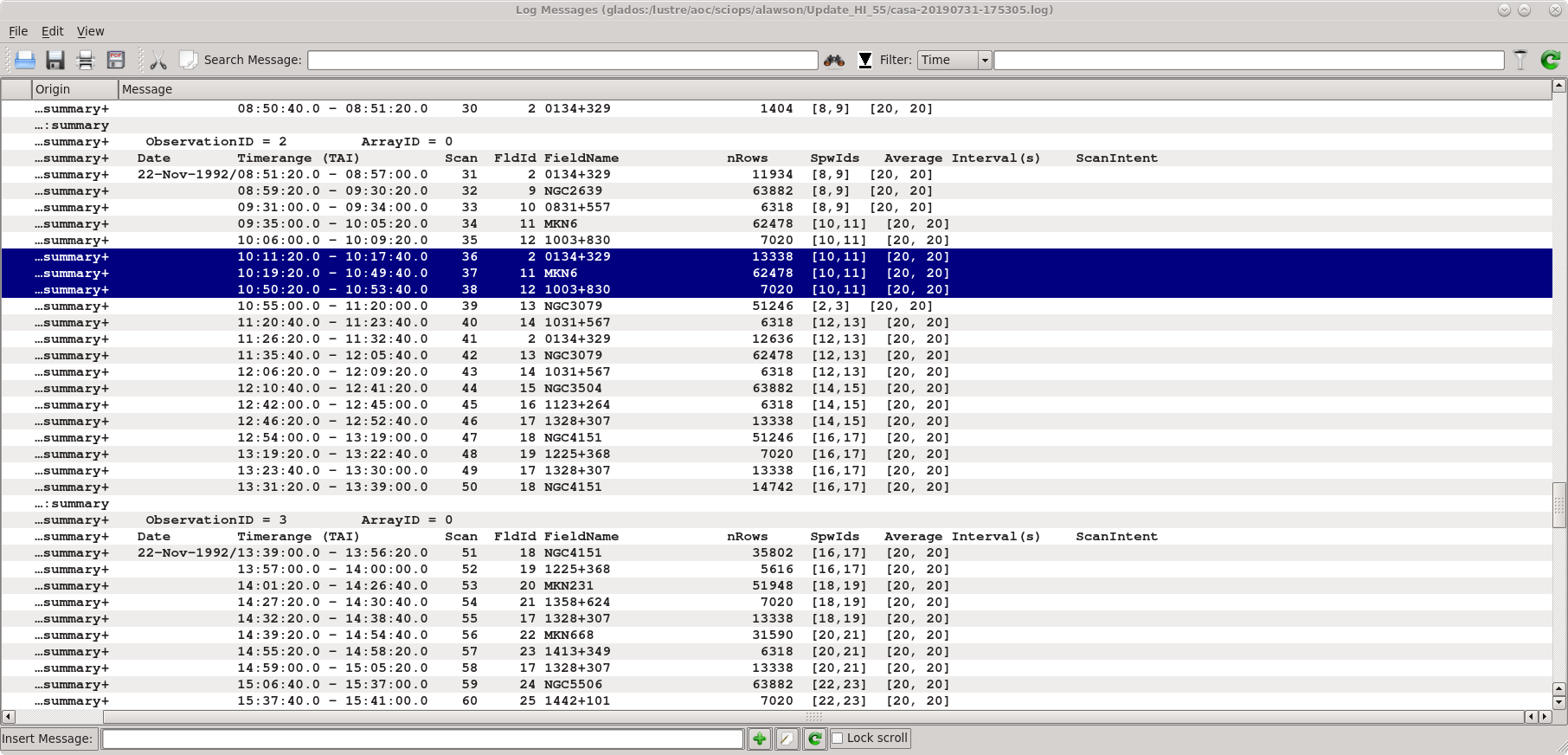
Using listobs and plotants we learn the source names, spectral windows, and viable reference antennas. A screenshot of the listobs output is given at right.
| Source | MKN6 |
| Flux Density Scale Cal | 0134+329 = 3C48 |
| Complex Gain Cal | 1003+830 |
| Central Antennas | VA27, VA09, VA23 |
| Spectral Window IDs | 10, 11 |
The selection of the spectral windows is key to getting the calibration right. Each science target in the multisource measurement set has a tuning respective of the source redshift, and the calibration observations are matched to those spectral windows. Were the spectral windows parameter (usually spw) left to its default value (all available spectral windows), many calibration routines would necessarily fail.
Editing the Data
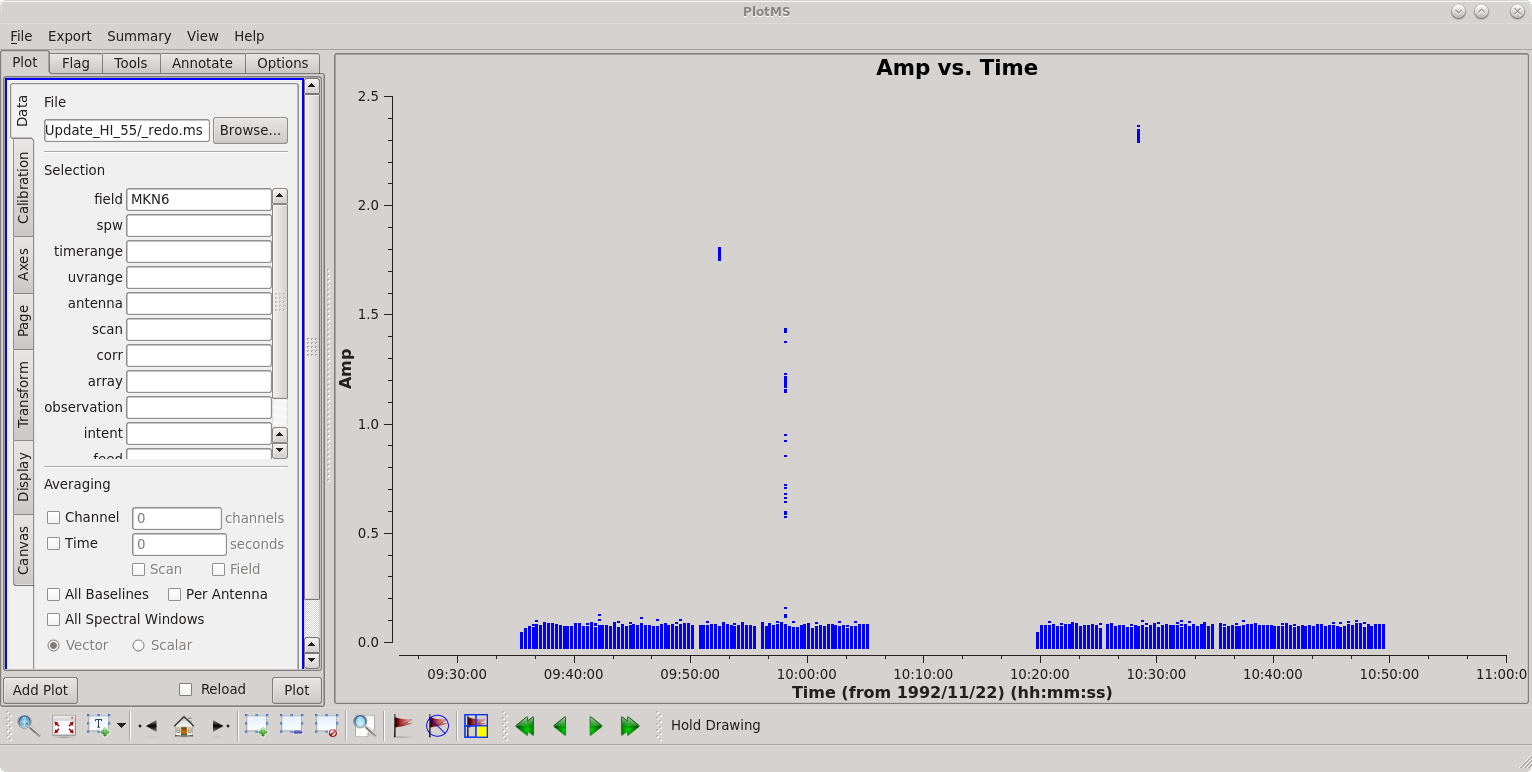
First inspect the data using plotms.
# In CASA
plotms(vis='ab658.ms', field='MKN6', xaxis='time', yaxis='amp')
There is some obvious bad data isolated in time during the observation; see the screenshot at right. We can use the locate tool in plotms to identify specific time ranges or antennas that are causing the problems and flag the bad data with the CASA task flagdata. For more information about flagging data in general, please see our Topical Guide: Flagging VLA Data. Hopefully you find three time ranges that are bad, which will require three calls to flagdata to flag the bad baselines.
# in CASA
flagdata(vis='ab658.ms',antenna='9&12', spw='10', timerange='1992/11/22/09:52:30.00')
flagdata(vis='ab658.ms',antenna='8&18', spw='10', timerange='1992/11/22/09:58:10.00')
flagdata(vis='ab658.ms',antenna='8&9', spw='10', timerange='1992/11/22/10:28:30.00')
Replot the data to confirm flagging has done what is expected.
Calibration
Calibration of HI absorption spectra follows the basic techniques outlined in the continuum tutorial and HI emission tutorial.
First, set the flux denisty of the flux density scale calibrator. Notice that we are being careful to keep track of the spectral windows and not using the default spw.
# In CASA
# set the flux denisty scale standard
setjy(vis='ab658.ms', field='0134+329', spw='10,11', model='', usescratch=True)
Bandpass calibration comes next.
# In CASA
# bandpass calibration
bandpass(vis='ab658.ms', spw='10,11', caltable='ab658.bcal', gaintable='', gainfield='', interp='', field='0134+329', selectdata=False, bandtype='B', solint='inf', combine='scan', refant='VA27')
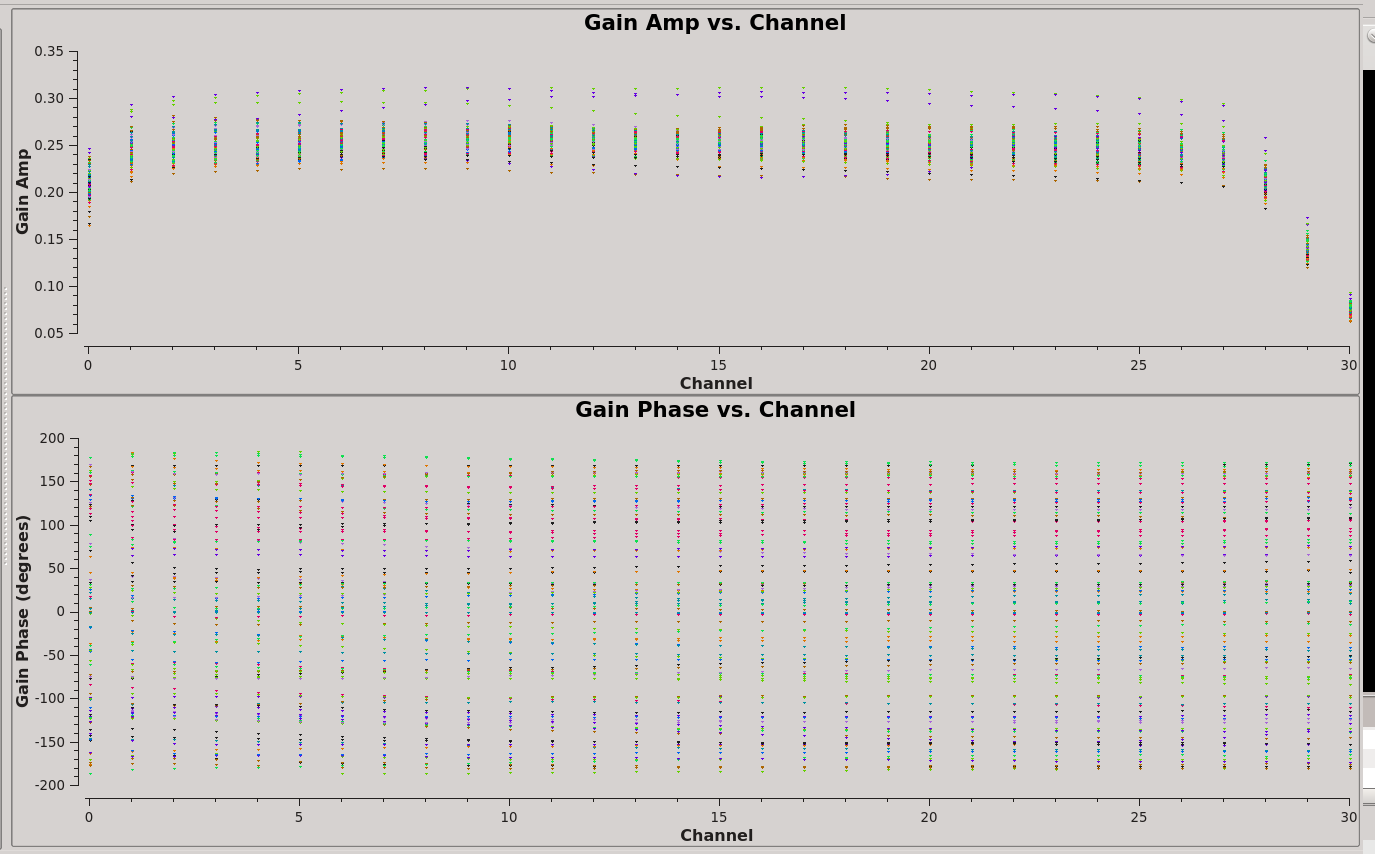
In order to perform the flux density scale and complex gain calibrations, we'll need to inspect the bandpass response curve to select appropriate channels to average. We want to choose those channels where the response is relatively flat. The result of plotms is shown at right: the bandpass is flat over channels 2:27.
# In CASA
# plot the bandpass calibration, amp vs channel
plotms(vis='ab658.bcal', spw='10~11', field='0134+329', gridrows=2, gridcols=1, rowindex=0, plotindex=0, yaxis='gainamp', xaxis='channel', coloraxis='Antenna1')
# plot the bandpass calibration, gain phase vs channel
plotms(vis='ab658.bcal', spw='10~11', field='0134+329', gridrows=2, gridcols=1, rowindex=1, plotindex=1, yaxis='gainphase', xaxis='channel', coloraxis='Antenna1', clearplots=False)
--
The following steps generate amplitude and complex gain solutions for the calibrators, and the fluxscale is bootstrapped from the flux density scale calibrator onto the complex gain calibrator, effectively turning the complex gain calibrator into a local flux density scale calibrator for the science target.
# In CASA
# generate amplitude and gain solutions for complex gain and flux density scale calibrators
gaincal(vis='ab658.ms', caltable='ab658.gcal', gaintable='ab658.bcal', gainfield='', interp='nearest', field='0134+329, 1003+830',
spw='10:2~27, 11:2~27', selectdata=False, gaintype='G', solint='inf', combine='', calmode='ap', minsnr=1.0, refant='VA27')
Note: CASA will print this message: "The the following spws have no corresponding cal spws in ab658.bcal: 0 1 2 3 4 5 6 7 8 9 12 13 14 15 16 17 18 19 20 21 22 23". This is expected because spw='10,11' are the only two spws being calibrated, spw='10,11' are not in the list presented by CASA.
# In CASA
# Bootstrap flux density scale
fluxscale(vis='ab658.ms', fluxtable='MKN6.fluxscale', caltable='ab658.gcal', reference='0134+329', transfer='1003+830')
The task fluxscale will give the bootstrapped flux density of the complex gain calibrator. If all goes well, something like the following should appear in the log window.
Beginning fluxscale--(MSSelection version)------- Found reference field(s): 0134+329 Found transfer field(s): 1003+830 ... Flux density for 1003+830 in SpW=10 (freq=1.3921e+09 Hz) is: 0.492452 +/- 0.00331148 (SNR = 148.711, N = 52) Flux density for 1003+830 in SpW=11 (freq=1.39425e+09 Hz) is: 0.489206 +/- 0.00287348 (SNR = 170.249, N = 52) ... Storing result in ab658.fluxscale
We should inspect the calibration solutions to make sure they are reasonable, but we'll be cavalier and tread forward. Apply the calibrations to the science target using applycal and split that target into its own measurement set.
# In CASA
# apply calibrations to science target
applycal(vis='ab658.ms', gaintable=['MKN6.fluxscale','ab658.bcal'], gainfield=['1003+830', '*'], interp=['linear','nearest'], field='MKN6', spw='10,11', spwmap=[], selectdata=False)
#In CASA
# split out the corrected data column (which is placed in the data column in the new MS) for our science target.
split(vis='ab658.ms', outputvis='ab658-MKN6.split.ms', field='MKN6', spw='10:2~27, 11:2~27', datacolumn='corrected')
- spw='10:2~27, 11:2~27 : Note that we have selected only the inner channels, 2 through 27 for spectral windows 10, 11.
Continuum Subtraction
Ideally, we would use plotms to identify the channels where HI absorption is present (see the HI emission tutorial.) The absorption line is however weak and isolated against one of a number of radio continuum sources in the data; as such, the absorption is not apparent in averaged visibilities. Instead, we'll have to produce a dirty cube using tclean and inspect the spectrum in the image domain.
Search for the Absorption Line
uvcontsub currently identifies continuum ranges by channel rather than frequency or velocity. We'll make two cubes, one for each spectral window. Note that the act of using split re-indexes the spectral windows and channels. Therefore channels 2~27 have been reindexed and are now channels 0~25 for both channels 10 & 11 (and spw='10,11' have now reindexed as spw='0,1').
# In CASA
# image cube for spectral window 0
tclean(vis='ab658-MKN6.split.ms', imagename='temp0', spw='0:0~25', specmode='cube', interpolation='nearest', niter=2000,
cell=['0.4arcsec', '0.4arcsec'], phasecenter='J2000 06h52m12.2 +74d25m37')
# In CASA
# make a new image cube with spectral window 1
tclean(vis='ab658-MKN6.split.ms', imagename='temp1', spw='1:0~25', specmode='cube', interpolation='nearest', niter=2000,
cell=['0.4arcsec', '0.4arcsec'], phasecenter='J2000 06h52m12.2 +74d25m37')
It's not ordinarily necessary to give the phase center, but this is a good opportunity to use the regridding capabilities of tclean. The data were originally taken in B1950 coordinates, and the observations followed the old practice of offsetting the pointing center slightly away from the source coordinates (this is not done with JVLA observations today). Here, we specify the J2000 coordinates (looked up on NED) and allow tclean to handle the precession and centering that we require.
Now we can inspect the cubes which have been named temp0.image and temp1.image. CASA will depreciate old viewer task, and no development for this task has been done for some time. So, we will instead use CARTA.
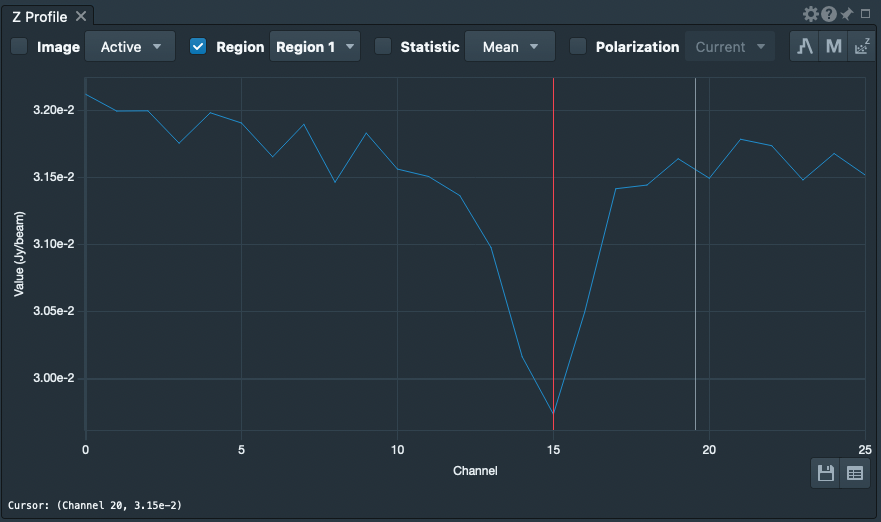
Now, use the Spectral Profiler tool in CARTA to generate a spectrum. The source spectrum in spw = 1 is shown in the figure at right.
- After opening the image, use the ellipse tool to make a region around the source.
- Next, open the Spectral Profiler tool. Since the default will be to show the x axis in LSRK, click the gear icon to open the settings of the Spectral Profiler:
- Change the Coordinate to Channel in the Conversion tab and Line Style to Lines in the Styling tab.
- Optional: Save the numerical data to a file. With the mouse over the SPectral Profiler plot, there should be two icons at the lower right: one looks like a disk for saving the image, the other a table for saving the numerical data: click the table button to save a csv file.
Perform the Continuum Subtraction
Looking over the plots and text files, only channels 0~25 in either spectral window contain usable data. The absorption line is located in 1:15 and surrounding channels. Just to play it safe, we'll use the channels outside of 1:10~20 (spectral window 1, channels 10-20) to define the continuum for subtraction.
# In CASA
uvcontsub(vis='ab658-MKN6.split.ms', outputvis='ab658-MKN6.split.ms.contsub', fitspec='0:0~25,1:0~9;21~25', fitorder=1)
uvcontsub in CASA 6.5 is a rewrite of this task, and several parameters have changed name and some are not longer available. Notable changes include:
- The task no longer automatically names and creates the continuum subtracted measurement set: outputvis=<name> is now required.
- fitspw has been renamed fitspec
- fitorder is now it's own parameter for use when only one fit order for all data is required
- The solint parameter has been removed.
If you need access to the old version, it is still in CASA 6.5 as uvcontsub_old.
Imaging the Continuum Subtracted Cube
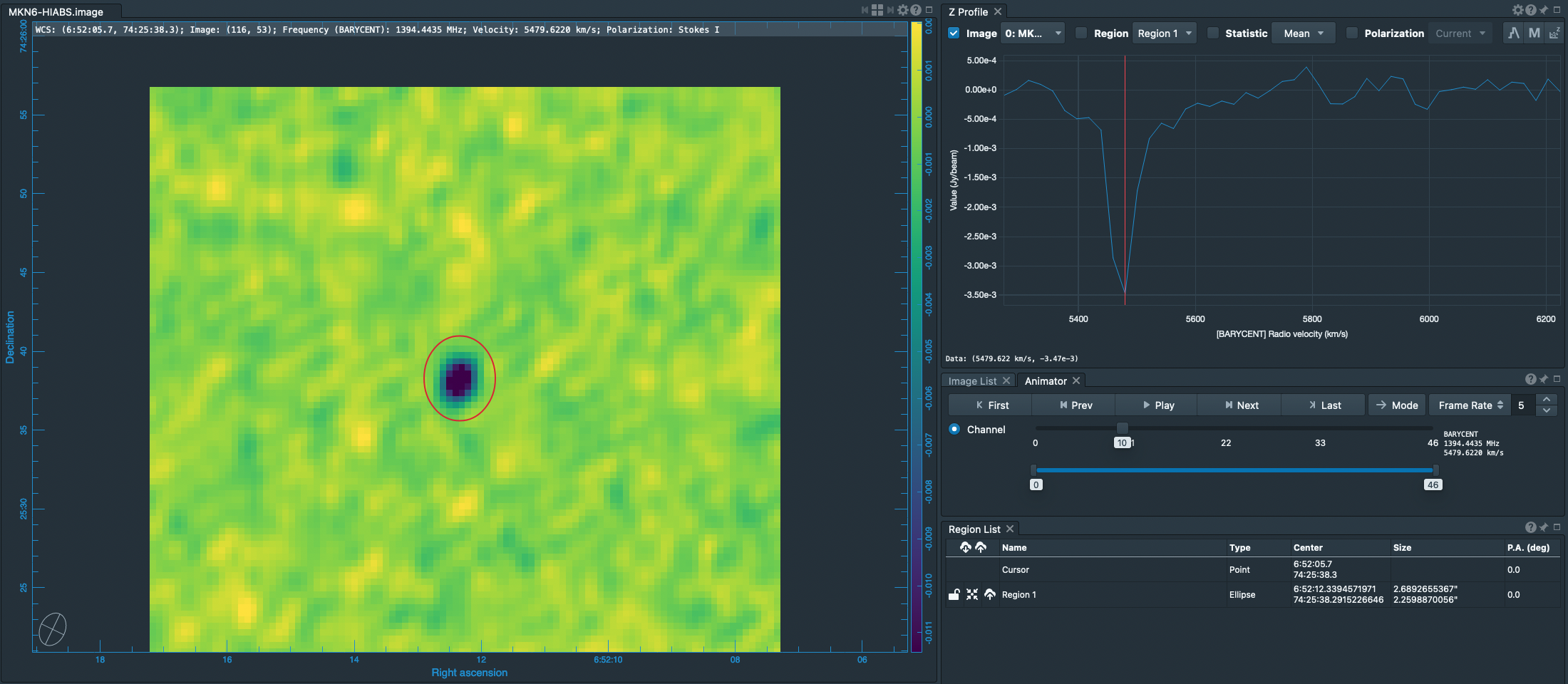
Inspecting the preliminary (continuum-containing) cubes, temp0.image and temp1.image, that we generated above, we can determine good parameters for the velocity axis.
# In CASA
tclean(vis='ab658-MKN6.split.ms.contsub', spw='', imagename='MKN6-HIABS', specmode='cube', start='-252.349km/s', interpolation='linear',
outframe='BARY', veltype='optical', restfreq='1420.405752MHz', niter=2000, threshold='1.0mJy', weighting='natural', cell=['0.4arcsec', '0.4arcsec'], phasecenter = 'J2000 06h52m12.2 +74d25m37')
- threshold='1.0mJy' : avoid over-cleaning since it appears that the channel rms is about 0.5 mJy/beam
- cell = ['0.4arcsec', '0.4arcsec'] : VLA-A configuration expects 1.5--2 arcsec beams. 0.4arcsec pixels ensure sampling the beam by better than 3x
The results are illustrated in the figure at right.
Imaging the Continuum Dataset
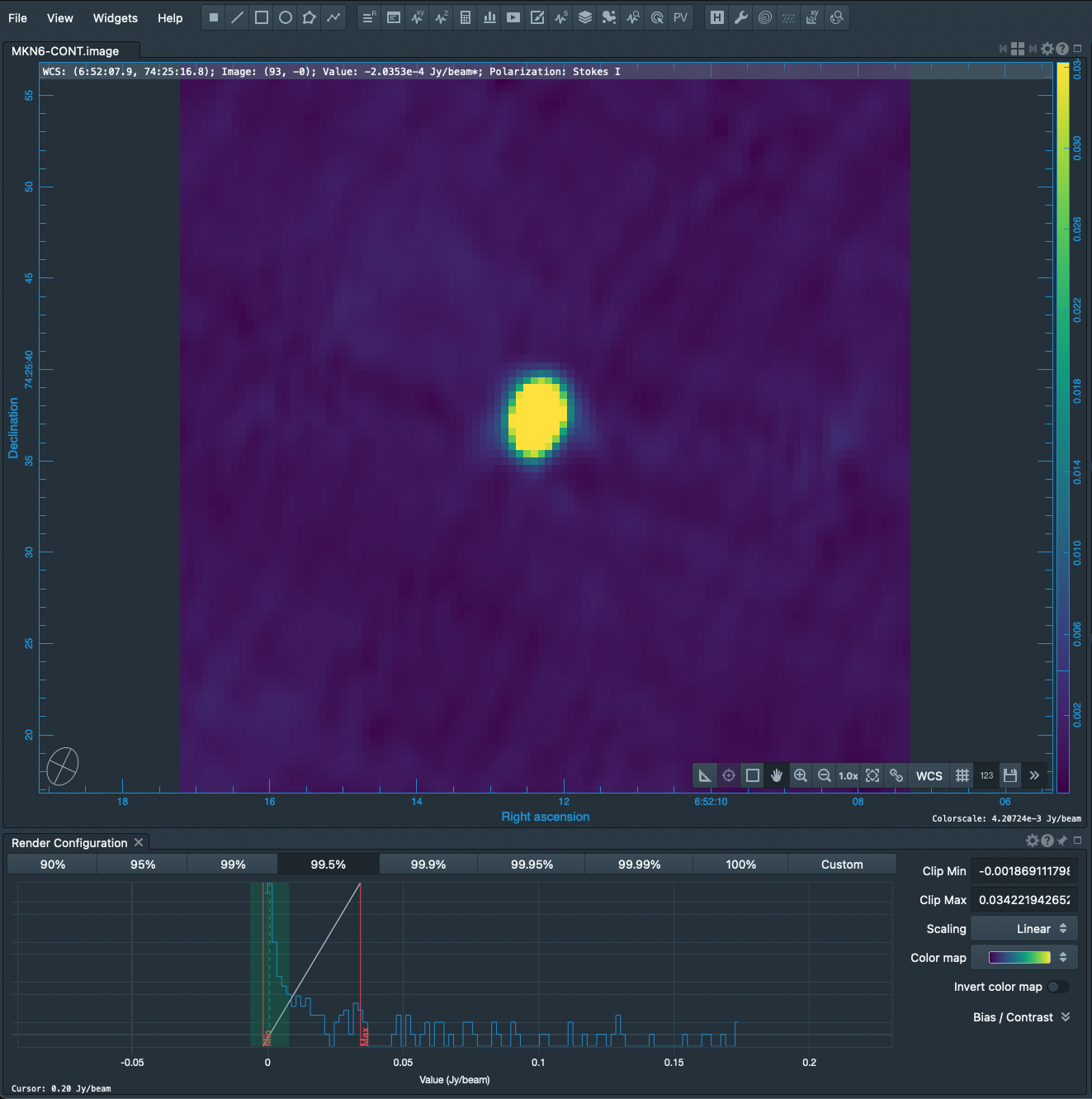
We can similarly image the continuum data with just a few changes of the tclean parameters. Here, we call tclean by selecting the spectral windows and channels pertaining to only the continuum.
# In CASA
tclean(vis='ab658-MKN6.split.ms', specmode='mfs', spw='0:0~25,1:0~9;21~25', imagename='MKN6-CONT', restfreq='1420.405752MHz', niter=2000,
threshold='1.0mJy', weighting='natural', cell=['0.4arcsec', '0.4arcsec'], phasecenter = 'J2000 06h52m12.2 +74d25m37')
The result is shown at right. The continuum image needs some more help. Phase errors produce the 6-pointed star pattern surrounding the source and can be healed using self-calibration. The striping across the field is actually the combination of sidelobes from neighboring sources; these sidelobes can be suppressed by cleaning flanking fields.
Extract the Absorption Spectrum
CARTA provides a handy first-look at the spectrum, but the extracted spectrum is an average over a spatial region. What we really want is the integrated spectrum, not the average. To do this, we'll use CASA's imstat, imval, and imhead tools to extract cube information to python variables and then let python build up the spectrum.
Extract the Spectrum: load the cube data into python arrays
First, we need to determine where in the cube to extract the spectrum; equivalently, we need to find the location of the minimum value in the cube. imstat is the tool for this.
# In CASA
cubeStat=imstat("MKN6-HIABS.image")
The variable cubeStat is now a python dictionary. To see what it contains, just enter the variable name:
# In CASA
cubeStat
and the following summary of cubeStat appears.
{'blc': array([0, 0, 0, 0]),
'blcf': '06:52:17.165, +74.25.16.997, I, 1.39542e+09Hz',
'max': array([0.00286756]),
'maxpos': array([40, 31, 0, 9]),
'maxposf': '06:52:13.193, +74.25.29.400, I, 1.39454e+09Hz',
'mean': array([-5.20264615e-06]),
'medabsdevmed': array([0.00032008]),
'median': array([-3.66626318e-06]),
'min': array([-0.01675498]),
'minpos': array([49, 53, 0, 10]),
'minposf': '06:52:12.299, +74.25.38.200, I, 1.39444e+09Hz',
'npts': array([470000.]),
'q1': array([-0.00032385]),
'q3': array([0.00031635]),
'quartile': array([0.0006402]),
'rms': array([0.00051103]),
'sigma': array([0.000511]),
'sum': array([-2.44524369]),
'sumsq': array([0.12274119]),
'trc': array([99, 99, 0, 46]),
'trcf': '06:52:07.331, +74.25.56.597, I, 1.39093e+09Hz'}
These entries can be accessed individually like an array variable. For example, the following commands copy the x and y positions of the absorption line to scalar variables.
# In CASA
# Press Enter or Return, then copy/paste the following:
x2extract = cubeStat['minpos'][0]
y2extract = cubeStat['minpos'][1]
--
Now, extract the spectrum using imval.
# In CASA
# Press Enter or Return, then copy/paste the following:
extractBox = "%d,%d" % (x2extract, y2extract) # copy the position to a string
cubeSpec = imval("MKN6-HIABS.image", box=extractBox, stokes='I')
--
cubeSpec is another python dictionary, and the spectrum is stored in cubeSpec['data'].
Comment: The absorption line source is unresolved by this observation, or, to put it another way, is entirely contained within a synthesized beam. The extraction at a single spatial pixel gives the integrated spectrum and therefore changes units from surface brightness (mJy/beam) to flux density (mJy). However, the data have been forced into a rectangular grid, and there's no guarantee that the absorption minimum centers within a pixel. Better to use imfit to determine more accurately the position of the minimum, and perhaps re-tclean with a new phasecenter. To avoid complicating the present tutorial, we'll just stick with the minimum in the current tclean grid.
Generate the frequency axis
We can derive the frequency axis from the header.
# In CASA
%cpaste
# Press Enter or Return, then copy/paste the following:
import numpy # make sure vector and array arithmetic options are loaded
cubeHead = imhead("MKN6-HIABS.image", mode="list")
nSpec = cubeStat['trc'][3] + 1 # get the number of frequency channels.
f0 = float(cubeHead['crval4']) # reference freq in Hz
df = float(cubeHead['cdelt4']) # channel width in Hz
i0 = cubeHead['crpix4'] # reference pixel
freqSpec = (numpy.arange(nSpec) - i0)*df + f0
--
Plot the spectrum using matplotlib
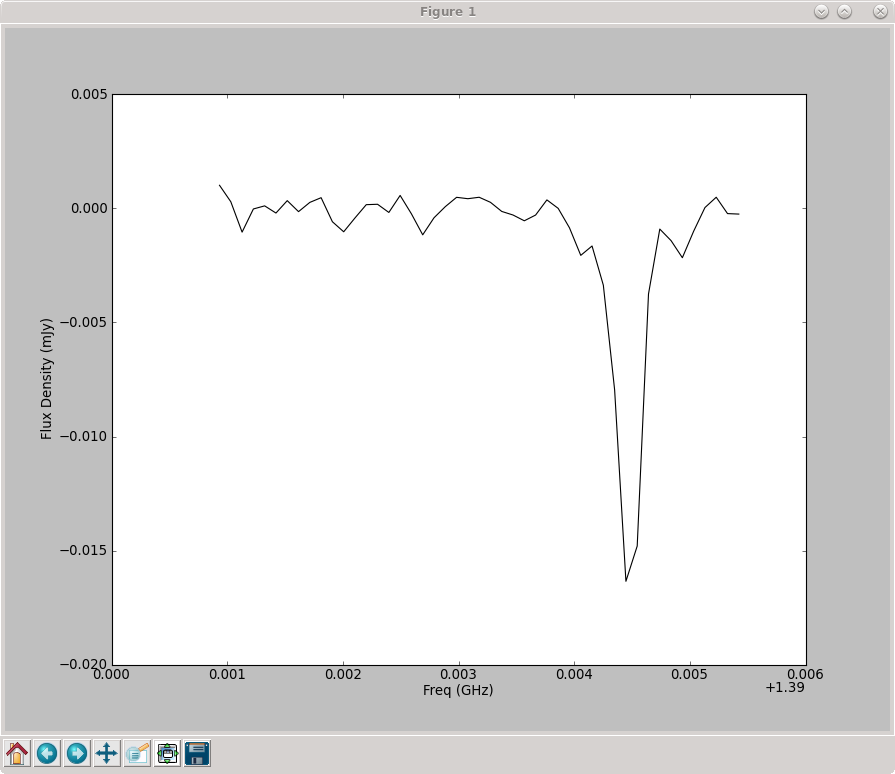
Now we have the spectrum stored in freqSpec, cubeSpec['data']. Use matplotlib.pyplot to plot the spectrum (see figure at right).
# In CASA
%cpaste
# Press Enter or Return, then copy/paste the following:
import matplotlib.pyplot as plt
plt.clf() # clear the plot (figure)
plt.plot(freqSpec/1.e9, cubeSpec['data'], 'k-')
plt.xlabel("Freq (GHz)")
plt.ylabel("Flux Density (mJy)")
plt.show()
--
A publication-quality figure: plot the spectrum against velocity
Nice, now let's make a velocity axis instead. We'll use the optical convention to convert frequency to velocity; the radio convention is offered as an alternative but is commented out.
# In CASA
%cpaste
# Press Enter or Return, then copy/paste the following:
import matplotlib.pyplot as plt
fRest = cubeHead['restfreq'][0]
velocity = 299792.458 * (fRest/freqSpec - 1.0) # optical convention, km/s
# velocity = 299792.458 * (1.0 - freqSpec/fRest) # radio convention, km/s
--
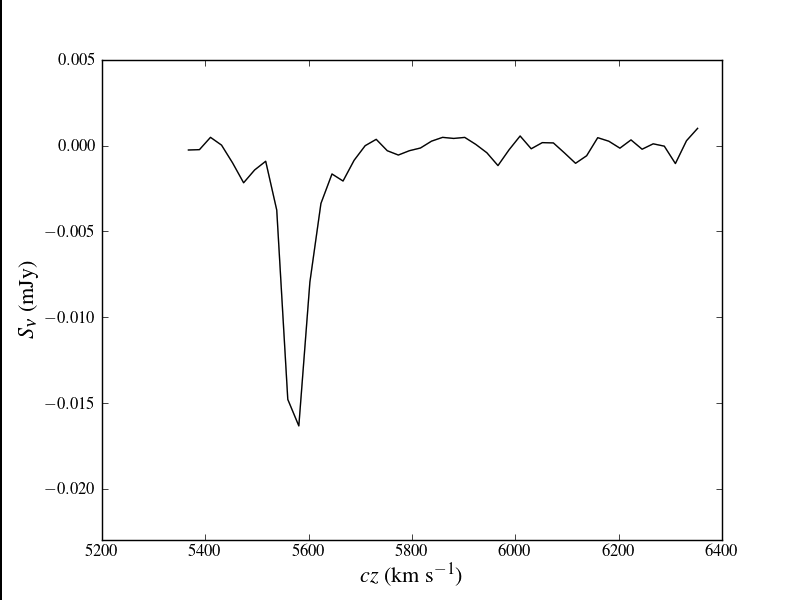
Plot the spectrum again, but this time try for publication-ready quality (see figure at right). This example is somewhat more clever to highlight the use of TeX typography in matplotlib. Note that you will have to have a compatible version of LaTeX installed for this to be successful.
# In CASA
# set up fonts
%cpaste
# Press Enter or Return, then copy/paste the following:
from matplotlib import rc
rc('font',**{'family':'serif','serif':['Times']})
rc('text', usetex=True)
plt.clf() # clear the plot (figure)
plt.plot(velocity, cubeSpec['data'], 'k-')
# the r prefix to the following format strings prevents \ from triggering an escape sequence,
# like \n for line feed
plt.xlabel(r"$cz$ (km s$^{-1}$)",fontsize=16)
plt.ylabel(r"$S_{\nu}$ (mJy)",fontsize=16)
plt.ylim(-0.023,0.005)
plt.savefig("mkn6-abs.eps") # save the figure as encapsulated postscript, suitable for journals
plt.savefig("mkn6-abs.png") # save the figure as a bitmap, better suited for astro-ph
--
Save the spectrum to a text file
It's handy to have a simple, columnar text file to inspect and analyze later. Or perhaps you might want to analyze the spectrum outside of CASA. Numpy makes it easy to save and restore text files.
# In CASA
# First, combine the spectrum into a single array
%cpaste
# Press Enter or Return, then copy/paste the following:
spectrum = numpy.vstack((velocity, cubeSpec['data']))
numpy.savetxt("mkn6.txt", numpy.transpose(spectrum))
--
Here's a listing of the first few lines of mkn6.txt.
5.367264765529167562e+03 -2.015652862610295415e-04 5.388621623140887095e+03 -3.016021801158785820e-04 5.409981470316914965e+03 5.079963593743741512e-04 5.431344307684780688e+03 2.443467565171886235e-05 5.452710135872680439e+03 -8.866344578564167023e-04 5.474078955508543004e+03 -2.227720571681857109e-03 5.495450767220763737e+03 -1.356674125418066978e-03 5.516825571637805297e+03 -1.001990865916013718e-03
Here's how to restore that text file back into CASA (or python, for that matter).
# In CASA
%cpaste
# Press Enter or Return, then copy/paste the following:
# import numpy # if you haven't already
spectrum = numpy.loadtxt("mkn6.txt",dtype="float")
x = spectrum[:,0]
y = spectrum[:,1]
--
Last checked on CASA Version 6.5.2